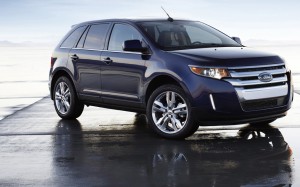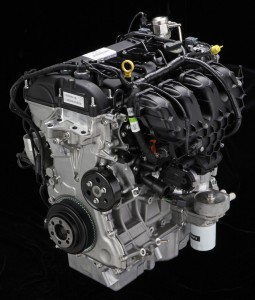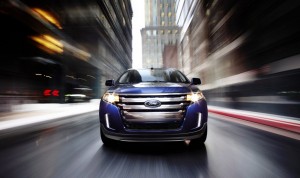
Ford has upgraded MyFordTouch and Sync and added the 2.0-liter EcoBoost option to the Edge crossover..
The best way to explain Sync and MyFordTouch is to compare it to another vehicle. The week before we drove a Ford Edge with the updated MyFordTouch, we drove an expensive luxury car from another manufacturer. With that car, just syncing a phone with Bluetooth was a difficult project – requiring a visit to the owner’s manual – mostly because of the voice recognition system’s limited voice command capabilities.
Last fall, Ford addressed issues with its MyFordTouch system, offering a software upgrade to all owners.
At a series of clinics, customers told Ford engineers and designers that they wanted better voice recognition, simpler graphics, bigger “buttons” and more instructions from the system on its use.
Did the changes work? We take a look at the latest version of MyFordTouch, along with the second in Ford’s line EcoBoost engines.
Ford’s voice-controlled infotainment system is the most advanced among any automaker. It understands more commands than other systems and it controls more functions. We found that the improved system in this Edge did a better job understanding voice commands, but there is still room for improvement.
Having driven many vehicles with Sync, we’ve found that it works best in Ford’s quietest cars. Lincoln MKS? Serenely quiet, superb voice recognition. Ford Fiesta? Not as quiet, less-accurate voice recognition.
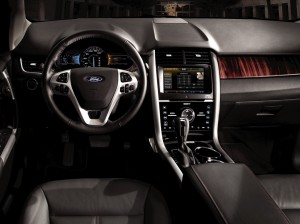
Ford listened to customers and improved MyFordTouch, but it could use more dedicated buttons for specific funtions..
The Edge falls in the middle. But it would appear that the promised improvements in voice recognition are real because this Edge did a better job understanding commands.
The graphic interface could still use more improvements. One of the changes was to make the virtual “buttons” on the system’s touchscreen bigger. They may be bigger, but there’s room to make them larger yet.
There’s also some limitations that a software upgrade just won’t solve. For example, turning on the seat heaters requires using the touchscreen to access the climate control – unless you use voice recognition. While Ford’s intent is to encourage drivers to use voice recognition, it wouldn’t be the worst thing in the world to include controls for the seat heaters on the touch-sensitive panel.
The piano-black panel – part of the optional upgraded Sony sound system – below the touchscreen has limited controls for climate control and entertainment. There’s one giant knob/button that controls basic radio functions. But the touch-sensitive buttons require a glance away from the windshield because there’s no actual button and the only feedback to let you know that you’ve actually pushed the button you want is a beep. Haptic feedback, as on some cellphones, would help. Lesser versions have a panel with slightly raised buttons.
Now, about that engine. The second EcoBoost is a direct-injected, turbocharged 2.0-liter four cylinder, producing 240 horsepower. What’s interesting about EcoBoost is it is a $995 option. The standard 3.5-liter V-6 – with sequential port injection – has more horsepower, but less torque. The EcoBoost is rated 240 horsepower and 270 pound-feet of torque while the V-6 is rated at 285/253. Also, the EcoBoost’s torque peak is at 3,000 rpm, 1,000 below that of the V-6.
The big draw for the EcoBoost is fuel mileage. Rated at 21 city and 30 highway, the engine improves on the V-6’s 19/27. We saw a bit more than 24 in a mix of rural two-lanes and freeways.
The EcoBoost Edge hardly feels like a turbo four cylinder. While some owners have reported feeling turbo lag, we didn’t. They could be sensing the six-speed transmission’s reluctance to offer up a lower gear when requested. The syrupy smooth transmission masks the turbo zinginess one might expect from a blown four cylinder.
It’s also smooth, smooth enough that buyers won’t miss the extra cylinders. Ford did an excellent job isolating any four-banger harshness.
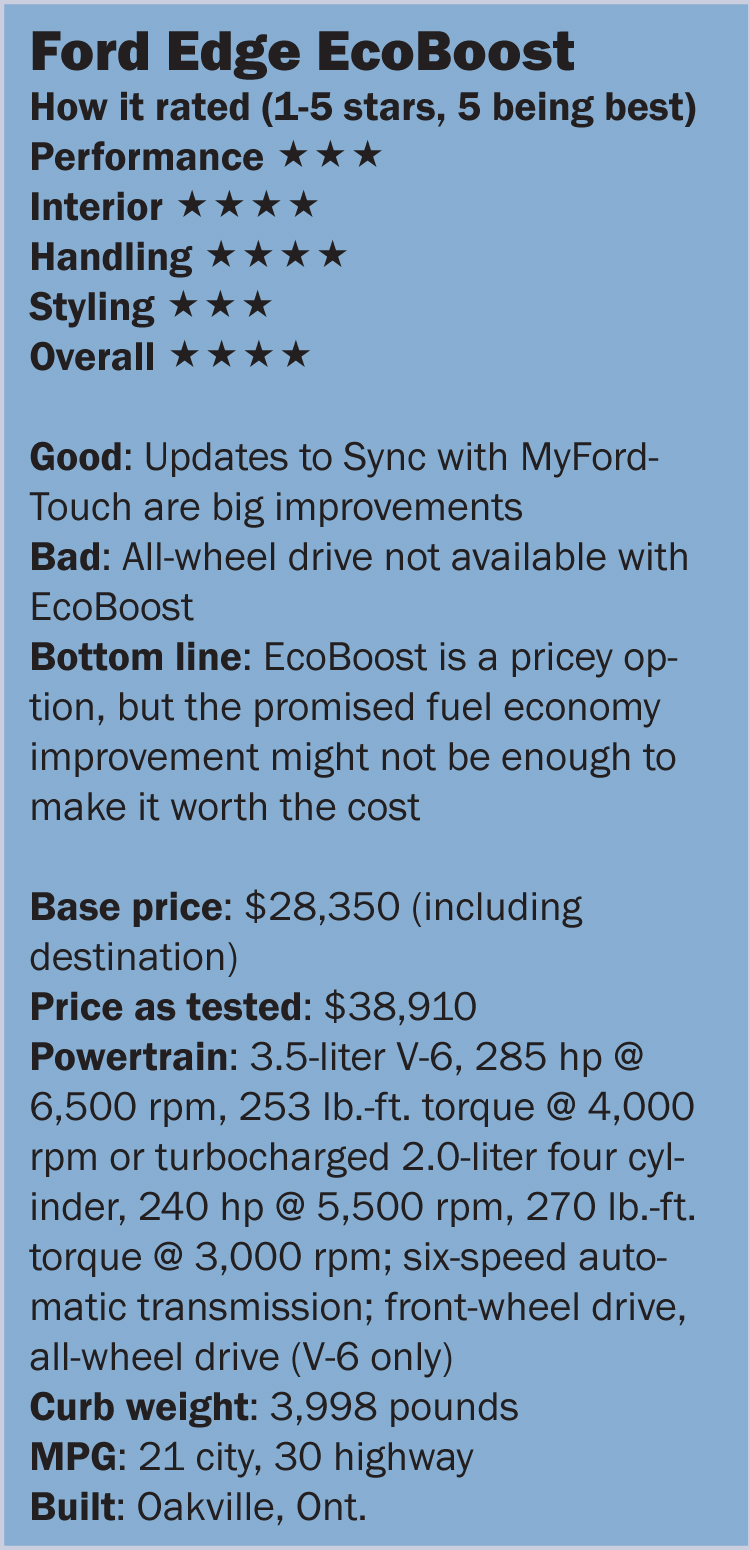 But buyers will miss the six’s extra burst of acceleration. Acceleration with the four cylinder is rather tepid. It feels like a small engine moving a big package, which it is.
But buyers will miss the six’s extra burst of acceleration. Acceleration with the four cylinder is rather tepid. It feels like a small engine moving a big package, which it is.
One area where the turbo four matches the V-6 is towing. Either way, the Edge can tow 3,500 pounds, if properly equipped. Towing more than a ton and a half with a four cylinder? How times have changed.
So, which to choose, turbo four or naturally aspirated V-6? A thousand bucks seems like a steep price to pay for fewer cylinders and less horsepower with improved fuel economy as the major benefit. In fact, a quick calculation shows that EcoBoost would save about $200 per year in fuel. So, it would take five years to pay for the engine option. It would seem that a detuned version of the V-6 might achieve similar mileage figures without the extra cost.
Beyond the upgraded MyFordTouch and the EcoBoost option, the Edge is familiar. A 2011 update added numerous improvements aimed at making the Edge more efficient and better to drive.
The seats are all-day comfortable, front and back. Those in the rear have excellent space. The Edge’s chunky shape means there is good cargo space in back. An extra cubbie hole or two in the sleek center console would be appreciated.
The low-gloss imitation wood trim is different than that in most cars these days because it actually resembles real wood from real trees.
Edge pricing opens at $28,350 (including destination) for a front-wheel-drive SE trim level with the V-6. The tester, a Limited, starts at $35,740. Add the EcoBoost engine, blind-spot monitoring ($495), power liftgate ($895) and voice-activated navigation for an out-the-door price of $38,910.
The Edge is still a compelling machine, one of the best two-row crossovers on the market. Does EcoBoost make sense? If you’re interested in doing something for the world by using less fuel to move your two-ton crossover, then yes, it makes sense. But if you’re looking to EcoBoost as a money move, the math just doesn’t work. But Sync gets better with every iteration the company releases.

